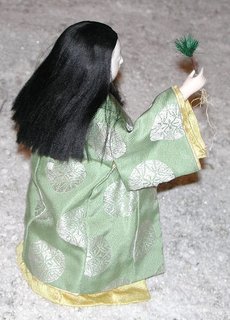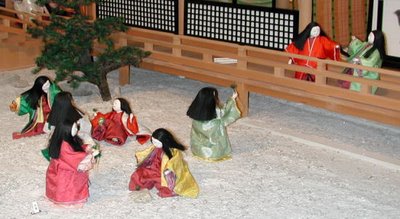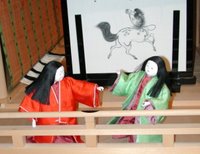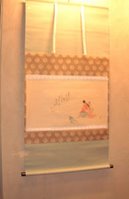:::::::::::::::::::::::::::::::::::::::::::::::::::::::::::::::::::::::::::::::::::::::::::::::::::::
Pulling Pine Seedlings (komatsu hiki)
***** Location: Japan
***** Season: New Year
***** Category: Observance
komatsubiki
*****************************
Explanation



Click on any of the dolls on this link to see the details!
© http://evagenji.hp.infoseek.co.jp/co-2002-12-9.htm
:::::::::::::::::::::::::::::::::::::::::::::::::::::::::::::::::::::::::::::::::::::::::::::::::::::
On the first day of the rat, people used to go to the fields and pull out the first herbs and greens (nanakusa, see below), including small pine seedlings with the roots. This practise started in the late Nara period and enjoyed by the members of the aristocracy at court. It was a well-loved ceremony and appreas on many paintings, screens and scrolls.
Pines, which do not falter during frost and snow, are a symbol for long life. The small pine seedlings were thought to be sepecially auspicious.
The sliding door paintings of Reizei Tamechika 令泉為恭 (1823-64) in the temple Daijuji 大樹寺, Okazaki Town, are especially famous.

xxxxxxxxxxxxxxxxxxxxxxxxxxxxx
Kigo related to this event
pulling out small pine seeldings, komatsu hiki 小松引
..... pulling pine seeldings, matsubiki 松引
.... young pine, wakamatsu 若松
first day of the rat, hatsune 初子
day of the rat 子の日
playing at the first rat day, ne no hi no asobi 子の日の遊び, 子日遊び
"small princess pine", hime komatsu 姫小松 ひめこまつ
..... "pine like a tea whisk", chasen matsu 茶筅松
pines of the day of the rat, ne no hi no matsu 子の日の松
greens of the day of the rat, ne no hi gusa 子の日草
dress for the day of the rat, ne no hi goromo 子の日衣
xxxxxxxxxxxxxxxxxxxxxxxxxxxxx
WKD : The Asian Lunar Calendar Reference
*****************************
Worldwide use
*****************************
Things found on the way
Hatsune, not to be mixed up with
"the first sound", hatsune 初音,
name of a gentle lady in the Tale of Genji.
*****************************
HAIKU
子の日しに都へ行かん友もがな
ne no hi shi ni miyako e ikan tomo mo gana
I would like to go to the capital
to enjoy the First Day of the Rat
but there is no friend to come with me . . .
Tr. Gabi Greve
Written in 1687 貞亨2年
Basho was again in his homeground, Iga Ueno, to spend the New Year.
Nozarashi.
. Matsuo Basho 松尾芭蕉 - Archives of the WKD .
:::::::::::::::::::::::::::::::::::::::::::::::::::::::::::::::::::::::::::::::::::::::::::::::::::::::
公家の手に豆出かしたる子の日哉
kuge no te ni mame dekashitaru ne no ki kana
the hands of aristocrats
get corns ...
day of the rat
横井也有 Yokoi Yayuu
http://www.geocities.jp/haikunomori/yayu/haru02.html
Aristocrats and their ladies were not used to manual labour of any kind.
:::::::::::::::::::::::::::::::::::::::::::::::::::::::::::::::::::::::::::::::::::::::::::::::::::::::
Haiku by Issa
榎迄引抜れたる子の日哉
enoki made hiki-nukeretaru ne no hi kana
even a nettle tree
is uprooted...
first day of Rat
Pulling up a young pine tree on the first day of Rat is a custom that originated in China. Shinji Ogawa explains that its purpose was to bring good luck or longevity. Here, instead of a pine, someone indiscriminantly uproots a young nettle tree.
袴着て芝にころりと子の日哉
hakama kite shiba ni gorori to ne no hi kana
with his sword's sheath
curled to sleep on the lawn...
first day of Rat
小松引人とて人のおがむ也
ko matsu hiku hito tote hito no ogamu nari
yanking up
a little pine
he says a prayer
Issa (Tr. David Lanoue
.......................................................................
-- in praise of cranes --
人の引小松の千代やさみすらん
hito no hiku ko matsu no chiyo ya samisuran
humans pull up
young thousand-year pines --
cranes seem unimpressed
This hokku is from the tenth month (November) of 1820, when Issa was in and around his hometown. On 10/5 Issa's second son Ishitarō was born, and on 10/16 Issa slipped and fell and discovered he had become temporarily partially paralyzed, so he may have brushed this hokku using only one hand and arm. It seems to be a hokku for the upcoming new year, since it evokes the custom of going out into the woods on the first day of the rat in the new year and pulling up pine saplings, roots and all, which were then taken home and revered as a symbol of longevity, since pines were said, according to a tradition going back to ancient China, to live a thousand years. Issa seems skeptical of this custom, and this hokku looks at it from the point of view of cranes, which were also said by tradition to live a thousand years.
Since the headnote says the hokku is written in praise of cranes, the verb in the last line seems to take the cranes as its subject.
In the hokku people who have come to the woods to pull up young pines on the first day of the rat no doubt envy the cranes when they see the birds in or below a grown pine nearby or perhaps flying through the sky above, and they hope to emulate the long-lived birds by taking home young pines and displaying them in their homes as prayers for a long life and happiness. The cranes, however, do not seem to return the respect shown by the humans when they catch sight of the impressive birds.
According to Issa the cranes seem to regard the humans as intruders. Perhaps they make cries of dismay, or perhaps they look at the humans with hard, cold stares. In any case, Issa senses that they don't seem happy to see these strange humans pulling up young pine trees. Following tradition, Issa may be suggesting that the cranes seem to look down on these out-of-place humans so much that they pity them. They themselves naturally live a thousand years -- a symbol for many, many long bird-years -- but all these poor humans can do is crudely imitate cranes by pulling up young pines, thereby ensuring that the saplings never live live to anything like their full lifespan. Issa's suggestion seems to be that humans should stop harming pines and other natural objects and instead learn how to live naturally long lives the way cranes do.
Soon after this hokku in Issa's diary are placed two hokku that are evidently prayers for the vigorous growth of Issa's second son Ishitarō, so the above hokku may also indirectly express Issa's hope that his second son will grow up to be a naturally strong person who will lead a spontaneously long, healthy life like a crane. Unfortunately Issa's second son died in the first month of the next year.
Chris Drake
*****************************
Related words
***** Pine (matsu, Japan) 松
***** Seven Herbs of Spring (haru no nanakusa) (Japan)
WKD: Ceremonies of Japan Nihon no Gyooji 日本の行事
:::::::::::::::::::::::::::::::::::::::::::::::::::::::::::::::::::::::::::::::::::::::::::::::::::::
[ . BACK to DARUMA MUSEUM TOP . ]
[ . BACK to WORLDKIGO . TOP . ]
:::::::::::::::::::::::::::::::::::::::::::::::::::::::::::::::::::::::::::::::::::::::::::::::::::::







6 comments:
.
men have plucked
little pines a thousand ages...
they must hate us!
人の引小松の千代やさみすらん
hito no hiku komatsu no chiyo ya samisuran
by Issa, 1820
Tr. David Lanoue
Samisu is an old verb with the modern equivalent, anadoru: to despise, to hold in contempt; Kogo dai jiten (Shogakukan 1983) 719.
http://cat.xula.edu/issa/
......................................................................
Gabi san, thank you for your information on [komatu hiku]
正直な所、小松引く、は全然実感が湧きません。
見たことも聞いたことも無しです。
岡山の方では聞きますか?
sakuo
Soba Field--
on the first day of Rat
picking a pine tree
sooba hara ne [no] hi no toki no matsu naran
相場原子の日の時の松ならん
by Issa, 1808
Pulling up a young pine tree on the first day of Rat is a custom that originated in China. Shinji Ogawa explains that its purpose was to bring good luck or longevity. In this haiku, So^ba is a place name, not soba (buckwheat noodles).
My translation is a bit free. Literally, according to Shinji, Issa ends the haiku with the statement, "it must be the pine." I imagine that someone is choosing a young pine to uproot.
Tr. David Lanoue.
子の日しに都へ行かん友もがな
nenohi shi ni / miyako e ika n / tomo mo gana
Matsuo Basho
More haiku about KUGE 公家
http://darumapilgrim.blogspot.jp/2012/11/kuge-aristocrats.html
chasen 茶筅 / 茶筌 / 茶せん tea whisk
.
https://omamorifromjapan.blogspot.jp/2017/05/chasen-tea-whisk.html
.
Post a Comment